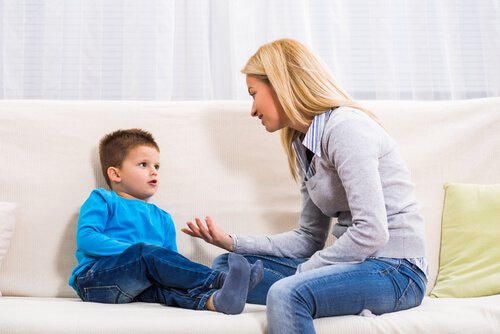What Is Mixed Receptive-Expressive Language Disorder

Mixed receptive-expressive language disorder is a condition that commonly affects children. Currently, specialists estimate that 1 in 20 kids have some type of language disorder. Generally, you can start to see symptoms after age 3. You should treat it with the help of professionals.
Children need to develop physical, cognitive, social and emotional skills in order to speak. When one or more of these isn’t properly developed, it can cause a language disorder. The disorder can be receptive, expressive or mixed.
What is mixed receptive-expressive language disorder?
Expressive language disorder is where it’s hard sending a message and making yourself understood. This doesn’t necessarily mean that you can’t understand what someone else is saying.
Receptive language disorder is where there is a problem interpreting spoken language. However, this doesn’t stop children from learning to communicate. They often learn to communicate in their own way.
For mixed receptive-expressive language disorder, it’s the sum of both of these disorders. Children with this disorder have difficulty understanding messages and expressing themselves through language.
This can make communication very difficult. As you know, communicating is based on understanding and being understood.
Causes of mixed receptive-expressive language disorder
Unfortunately, it’s common to confuse language disorders with developmental problems. However, these are two different things. Although it’s true that these disorders can be associated with some developmental problems, they aren’t the only cause.

On the other hand, language disorders can also stem from damage to the central nervous system. This is called aphasia. For some kids with mixed receptive-language disorder, they have a brain injury.
Often, it’s not possible to identify the specific cause of mixed language disorder in kids. In these cases, you need to talk with your doctor.
First signs of the disorder
Generally, these symptoms start in childhood. This is when kids’ bodies are growing physically and mentally. Most kids learn language completely naturally.
As we’ve mentioned, the first signs of language disorders usually appear around age 3. When we talk about mixed disorders, these may include one or more symptoms:
“To articulate language, you need to develop physical, cognitive, social and emotional capacities. When one or more of these isn’t properly developed, language disorders appear.”
What are the symptoms?
Next, we’ll summarize the most common symptoms of mixed receptive-expressive language disorder in children:
- Difficulty understanding or following directions. The main difficulty is though oral language.
- Problems organizing and summarizing thoughts or emotions. It’s difficult to form coherent sentences.
- Learning difficulties. Children with mixed language disorders usually have learning problems. This is because learning is based mostly on communication.
- The consequences of learning difficulties are low school performance and not wanting to go to school. Also, their intellectual progress is lower than in other children.
- Difficulties structuring sentences. Some children can make very short and incomplete sentences to try and express themselves. However, others can make sentences that don’t connect words well. These are difficult to understand.
- In some cases, difficulty maintaining agreement between verb tenses. For example, difficulty staying in the past, present or future tense.
- Another symptom is called “language vices.” For example, some kids might stutter or repeat themselves. On the other hand, some kids may repeat onomatopoeia frequently. This indicates that they’re having trouble finding the words to make a sentence.
- Social problems. Social problems aren’t direct signs of this disorder. However, kids with language disorders may also have social problems.
- A child who has trouble communicating may also experience trouble playing with other kids. In some cases, researchers see that social problems lead to behavioral problems or depression.

How to treat mixed receptive-expressive language disorder
Treating mixed receptive-expressive language disorder requires professional help. In general, speech therapy is one of the best ways to treat it.
As you can see, it’s very important not to be ashamed or afraid to consult your pediatrician. It’s necessary to have clinical support from an expert when it comes to children’s language disorders.
Mixed receptive-expressive language disorder is a condition that commonly affects children. Currently, specialists estimate that 1 in 20 kids have some type of language disorder. Generally, you can start to see symptoms after age 3. You should treat it with the help of professionals.
Children need to develop physical, cognitive, social and emotional skills in order to speak. When one or more of these isn’t properly developed, it can cause a language disorder. The disorder can be receptive, expressive or mixed.
What is mixed receptive-expressive language disorder?
Expressive language disorder is where it’s hard sending a message and making yourself understood. This doesn’t necessarily mean that you can’t understand what someone else is saying.
Receptive language disorder is where there is a problem interpreting spoken language. However, this doesn’t stop children from learning to communicate. They often learn to communicate in their own way.
For mixed receptive-expressive language disorder, it’s the sum of both of these disorders. Children with this disorder have difficulty understanding messages and expressing themselves through language.
This can make communication very difficult. As you know, communicating is based on understanding and being understood.
Causes of mixed receptive-expressive language disorder
Unfortunately, it’s common to confuse language disorders with developmental problems. However, these are two different things. Although it’s true that these disorders can be associated with some developmental problems, they aren’t the only cause.

On the other hand, language disorders can also stem from damage to the central nervous system. This is called aphasia. For some kids with mixed receptive-language disorder, they have a brain injury.
Often, it’s not possible to identify the specific cause of mixed language disorder in kids. In these cases, you need to talk with your doctor.
First signs of the disorder
Generally, these symptoms start in childhood. This is when kids’ bodies are growing physically and mentally. Most kids learn language completely naturally.
As we’ve mentioned, the first signs of language disorders usually appear around age 3. When we talk about mixed disorders, these may include one or more symptoms:
“To articulate language, you need to develop physical, cognitive, social and emotional capacities. When one or more of these isn’t properly developed, language disorders appear.”
What are the symptoms?
Next, we’ll summarize the most common symptoms of mixed receptive-expressive language disorder in children:
- Difficulty understanding or following directions. The main difficulty is though oral language.
- Problems organizing and summarizing thoughts or emotions. It’s difficult to form coherent sentences.
- Learning difficulties. Children with mixed language disorders usually have learning problems. This is because learning is based mostly on communication.
- The consequences of learning difficulties are low school performance and not wanting to go to school. Also, their intellectual progress is lower than in other children.
- Difficulties structuring sentences. Some children can make very short and incomplete sentences to try and express themselves. However, others can make sentences that don’t connect words well. These are difficult to understand.
- In some cases, difficulty maintaining agreement between verb tenses. For example, difficulty staying in the past, present or future tense.
- Another symptom is called “language vices.” For example, some kids might stutter or repeat themselves. On the other hand, some kids may repeat onomatopoeia frequently. This indicates that they’re having trouble finding the words to make a sentence.
- Social problems. Social problems aren’t direct signs of this disorder. However, kids with language disorders may also have social problems.
- A child who has trouble communicating may also experience trouble playing with other kids. In some cases, researchers see that social problems lead to behavioral problems or depression.

How to treat mixed receptive-expressive language disorder
Treating mixed receptive-expressive language disorder requires professional help. In general, speech therapy is one of the best ways to treat it.
As you can see, it’s very important not to be ashamed or afraid to consult your pediatrician. It’s necessary to have clinical support from an expert when it comes to children’s language disorders.
All cited sources were thoroughly reviewed by our team to ensure their quality, reliability, currency, and validity. The bibliography of this article was considered reliable and of academic or scientific accuracy.
- Boyle, J., McCartney, E., O’HARE, A. N. N. E., & Law, J. (2010). Intervention for mixed receptive–expressive language impairment: a review. Developmental Medicine & Child Neurology, 52(11), 994-999. https://onlinelibrary.wiley.com/doi/abs/10.1111/j.1469-8749.2010.03750.x
- Lisa, R., Pola, R., Franz, P., & Jessica, M. (2019). Developmental language disorder: Maternal stress level and behavioural difficulties of children with expressive and mixed receptive-expressive DLD. Journal of communication disorders, 80, 1-10. https://www.sciencedirect.com/science/article/abs/pii/S0021992418300431
- Parra, D. J. L. EL TRASTORNO MIXTO DEL LENGUAJE RECEPTIVO-EXPRESIVO. ANÁLISIS DE UN CASO. https://rieoei.org/historico/deloslectores/286Luque.pdf
This text is provided for informational purposes only and does not replace consultation with a professional. If in doubt, consult your specialist.








